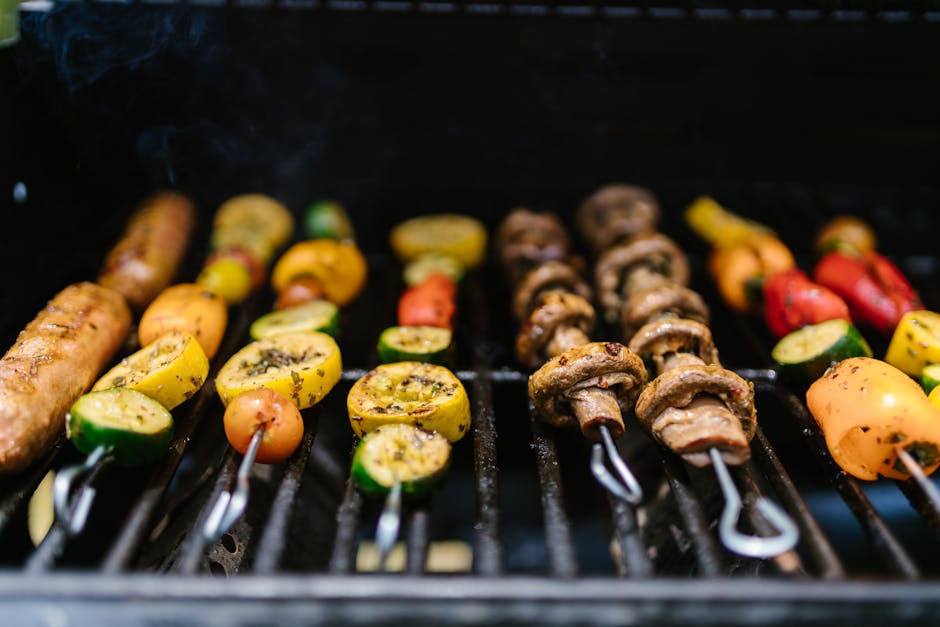The Ultimate Guide to Delicious and Healthy Vegetable Kabobs: Recipes, Tips, and More!
Vegetable kabobs are a vibrant and versatile way to enjoy a healthy and delicious meal. Whether you’re grilling outdoors on a summer evening or roasting them in the oven during colder months, these colorful skewers offer a fantastic combination of flavor and nutrition. This comprehensive guide will walk you through everything you need to know about making perfect vegetable kabobs, from selecting the best ingredients to mastering grilling techniques and exploring creative variations.
Choosing the Right Vegetables
The beauty of vegetable kabobs lies in their adaptability. You can use almost any vegetable you enjoy, but choosing vegetables that hold their shape well during cooking is crucial. Some excellent choices include:
- Bell peppers: Offer a delightful crunch and come in a rainbow of colors – red, yellow, orange, and green.
- Zucchini and yellow squash: These tender summer squashes add a mild, slightly sweet flavor.
- Onions: Red onions provide a sharp bite, while white or yellow onions offer a milder flavor.
- Cherry tomatoes: These burst with juicy sweetness and add a pop of color.
- Mushrooms: Button, cremini, or portobello mushrooms add an earthy, savory note.
- Eggplant: Cubed eggplant adds a rich, smoky flavor when grilled.
- Asparagus: Tender asparagus spears offer a delicate, slightly grassy taste.
- Broccoli florets: Provide a nutritious and slightly bitter counterpoint to sweeter vegetables.
- Red onion: Adds a pungent bite that balances sweetness.
Tip: Consider the density of your vegetables. Denser vegetables like bell peppers and onions will require slightly longer cooking times than softer vegetables like zucchini.

Preparing Your Vegetables for the Grill or Oven
Proper preparation is key to achieving perfectly cooked vegetable kabobs. Here’s what you need to do:
- Wash and chop: Thoroughly wash all vegetables and cut them into approximately 1-inch pieces. Ensure all pieces are roughly the same size for even cooking.
- Soaking (optional): For tougher vegetables like eggplant, consider soaking them in salted water for 15-20 minutes to draw out excess moisture and prevent bitterness. Pat them dry before assembling the kabobs.
- Soaking (for wooden skewers): If using wooden skewers, soak them in water for at least 30 minutes before using to prevent burning.
- Assemble the kabobs: Thread the vegetables onto skewers, alternating colors and types for visual appeal and flavor variation. Leave a little space between the pieces for even cooking.
Grilling Your Vegetable Kabobs
Grilling imparts a delicious smoky flavor to vegetable kabobs. Follow these steps for perfectly grilled skewers:
- Preheat your grill: Preheat your grill to medium-high heat.
- Oil the grill grates: Lightly oil the grill grates to prevent sticking.
- Grill the kabobs: Place the kabobs on the preheated grill and cook for 8-12 minutes, turning occasionally, until the vegetables are tender and slightly charred. Cooking time will depend on the size and density of the vegetables.
- Check for doneness: The vegetables should be tender when pierced with a fork. Slightly charred edges add a desirable smoky flavor.
Roasting Your Vegetable Kabobs
Roasting offers a convenient alternative to grilling, perfect for colder months or when you don’t have access to a grill.
- Preheat your oven: Preheat your oven to 400°F (200°C).
- Prepare a baking sheet: Line a baking sheet with parchment paper or foil for easy cleanup.
- Arrange the kabobs: Place the assembled kabobs on the prepared baking sheet.
- Roast the kabobs: Roast for 20-25 minutes, flipping halfway through, until the vegetables are tender and slightly browned.
Delicious Marinades and Seasonings
Marinades and seasonings elevate the flavor of your vegetable kabobs. Experiment with different combinations to find your favorites:
- Lemon Herb Marinade: Combine olive oil, lemon juice, garlic, oregano, and thyme.
- Balsamic Glaze Marinade: Whisk together balsamic vinegar, honey, and Dijon mustard.
- Spicy Peanut Sauce Marinade: Mix peanut butter, soy sauce, rice vinegar, honey, and sriracha.
- Simple Salt and Pepper: Sometimes, the simplest seasoning is best. Season generously with salt, pepper, and a touch of garlic powder.
Serving Suggestions
Vegetable kabobs are incredibly versatile and can be served in various ways:
- As a main course: Serve with a side of quinoa, rice, or couscous for a complete and satisfying meal.
- As a side dish: Pair them with grilled chicken, fish, or steak.
- As an appetizer: Cut the kabobs into smaller pieces and serve them as a delicious appetizer.
Recipe Variations: Beyond the Basics
Mediterranean Vegetable Kabobs
Combine zucchini, bell peppers, cherry tomatoes, red onion, and Kalamata olives. Marinate in a mixture of olive oil, lemon juice, oregano, and feta cheese.

Sweet and Spicy Vegetable Kabobs
Use bell peppers, pineapple chunks, red onion, and cherry tomatoes. Marinate in a mixture of soy sauce, honey, ginger, and chili flakes.
Creamy Pesto Vegetable Kabobs
Toss your favorite vegetables with pesto before threading onto skewers. Grill or roast until tender.

Tips for Success
- Don’t overcrowd the grill or baking sheet, allowing for even cooking.
- Use metal skewers for even cooking and avoid soaking.
- Experiment with different vegetables and marinades to find your perfect combination.
- Pre-cut your vegetables to save time and ensure even cooking.
- Leftovers can be stored in the refrigerator for up to 3 days.
Vegetable kabobs are a delightful and healthy addition to any meal. With a little creativity and these helpful tips, you can create delicious and memorable kabobs that everyone will enjoy!

